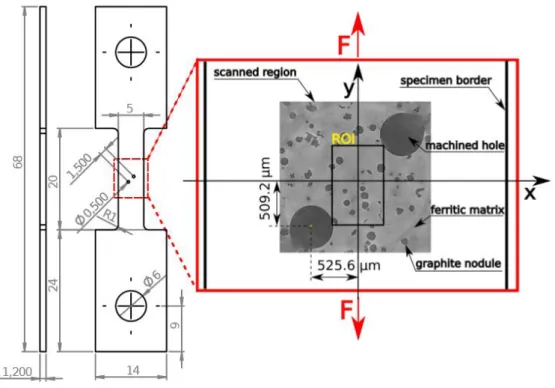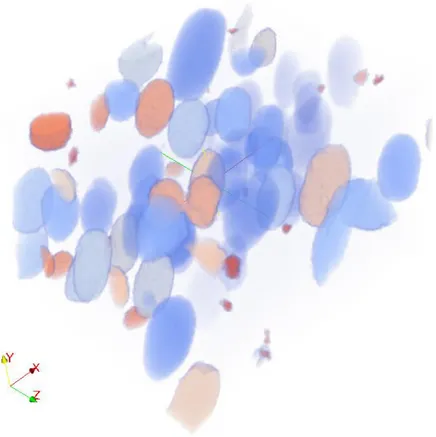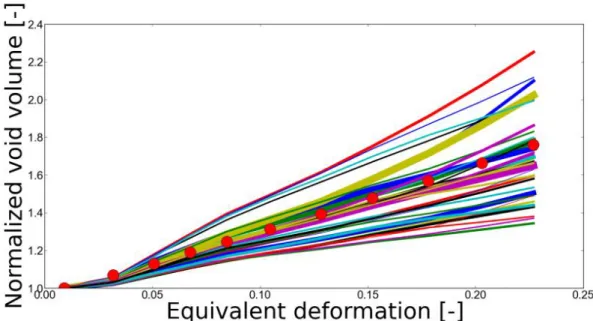HAL Id: hal-01899285
https://hal.archives-ouvertes.fr/hal-01899285
Submitted on 19 Oct 2018HAL is a multi-disciplinary open access archive for the deposit and dissemination of sci-entific research documents, whether they are pub-lished or not. The documents may come from teaching and research institutions in France or abroad, or from public or private research centers.
L’archive ouverte pluridisciplinaire HAL, est destinée au dépôt et à la diffusion de documents scientifiques de niveau recherche, publiés ou non, émanant des établissements d’enseignement et de recherche français ou étrangers, des laboratoires publics ou privés.
Influence of heterogeneous microstucture on the
micromechanisms of ductile fracture
Victor-Manuel Trejo-Navas, Modesar Shakoor, Marc Bernacki, Pierre-Olivier
Bouchard
To cite this version:
Victor-Manuel Trejo-Navas, Modesar Shakoor, Marc Bernacki, Pierre-Olivier Bouchard. Influence of heterogeneous microstucture on the micromechanisms of ductile fracture. 13e colloque national en calcul des structures, Université Paris-Saclay, May 2017, Giens, Var, France. �hal-01899285�
CSMA 2017
13ème Colloque National en Calcul des Structures 15-19 mai 2017, Presqu’île de Giens (Var)
Influence of heterogeneous microstucture on the micromechanisms of
ductile fracture
V. Trejo1, M. Shakoor1, M. Bernacki1,P.-O.Bouchard1
1
MINES ParisTech, PSL ResearchUniversity, CEMEF-Centre de mise en forme des matériaux, CNRS UMR 7635, CS 10207 rue Claude Daunesse, 06904 Sophia Antipolis Cedex, France, victor-manuel.trejo_navas@mines-paristech.fr
Abstract — Appropriate understanding of the ductile damagemicromechanisms is necessary for the
accurate prediction of fracture of metallic materials under complex multiaxial and non-proportional loadings. In this study, a combination of Laminography, Digital Volume Correlation and Finite Element (FE) Modelling is used in order to study real microstructures under realistic boundary conditions. The proposed FE framework based on advanced meshing capabilities is able to account for nucleation, growth and coalescence in 3D. Emphasis is made on the effect of the heterogeneous microstructure.
Mots clefs — Ductile damage, heterogeneous microstructure, finite element modelling.
1. Introduction
Metallic materials can undergo brittle or ductile fracture. Brittle metals experience fracture after very little deformation, while ductile metals sustain higher plastic strains before complete failure.Ductile fracture is a progressive event: the material progressively loses load-bearing capacity due to failure mechanisms occurring at the microscale.
A wide variety of mechanical tests and specimen types are employed in the macroscopic study of ductile fracture in order to assess the effect of the stress state and the deformation history. This has proved to be a very useful approach.However, difficulties are encountered when trying to predict the influence of thermomechanical processing conditions, and complex non-proportional loading paths on ductile fracture. In addition, the role of the microstructure is often accounted for in a phenomenological way.
The micromechanical approach studies at the microscale the events occurring during the loss of load-bearing capacity that precedes fracture. At this scale, damage is usually related to microvoids, which evolution is usually described in terms of three mechanisms: nucleation, growth and coalescence. Nucleation can occur in inclusions by particle fracture or debonding of the matrix-particle interface. Void growth is driven by the plastic deformation of the matrix. Coalescence is usually described through three different mechanisms: internal necking of the intervoid ligament, void-sheet coalescence and necklace coalescence.Though very challenging, the understanding and modelling of these mechanisms would considerably improve the prediction of ductile fracture under the aforementioned complex conditions.
The micromechanical study of ductile fracture has recently evolved significantly. Seminal analyses considered the growth of a single void in ahomogeneous medium. This is, for example, how Rice and Tracey developed their void growth model [1]. Another remarkable result was obtained by Gurson [2] through homogenization theory, in the form of a yield surface for porous media.
Improvements in numerical methods to consider more complicated arrangements. The unit-cell approach constitutes a classic approach in this category: a single inclusion or void is simulated in a representative volume element typically under periodic boundary conditions. Different microstructural arrangements under varied stress states have been studied with this method. This is, for example, how
Pardoen and Hutchinson [3] extended Thomason’s coalescence criterion to include the effect of void shape and strain hardening. Although very useful, the limitations of this approach are its necessary simplifying hypothesis with respect to void/inclusion shape and distribution.
Thanks to recent advances in X-ray imaging, detailed experimental information in the bulk material is now available in the initial state as well as during the damage and failure processes with in-situ tests. In this work, a framework that combines in-situ Synchrotron Radiation Computed Laminography (SRCL), Digital Volume Correlation (DVC) and Finite Element (FE) modelling is employed to study the effect of heterogeneities in the ductile damage micromechanisms. Thanks to this framework, real microstructures are studied under realistic boundary conditions with no simplifying hypotheses on void shape and distribution.
2. Methodology
The employedmethodologyis a combination of Synchrotron Radiation ComputedLaminography (Centre des Matériaux, MINES ParisTech), Digital Volume Correlation (Laboratoire de Mécanique et Technologie – École Normale Supérieure -Paris-Saclay) and FiniteElementmodelling (Centre de Mise en Forme de Matériaux, MINES ParisTech).
2.1. Synchrotron Radiation Computed Laminography
In the same manner as in X-ray tomography, a high energy source is directed at the observed specimen and the remaining beam after absorption is captured with sensors. Several scans are required in order to produce a three-dimensional image after a reconstruction process. The particularity of laminography is that flat specimens can be studied [4]. This technique is used in this work to obtain detailed three-dimensional images of the microstructure. Additionally, three dimensional images are produced during a mechanical test and the evolution of the microstructure, including damage events, is captured.
2.2. Digital Volume Correlation
Thanks to the availability of three-dimensional images of the same microstructural features during an in-situ test, DVC can be employed [5]. DVC is a 3D extension of Digital Image Correlation (DIC). Since no speckle pattern is possible in the bulk of the material, the minimization process is guided by the contrast, in terms of gray levels, resulting from the microstructural features. The result of this process is three dimensional displacements and strain fields.
2.2. Finite Element modeling
An advanced finite element approach with a level-set formalism and body-fitted immersed meshing capabilities is used to model the microstructural evolution and its complex topological changes up to large plastic strains [6]. The coupling with SRCL and DVC allows real microstructures and realistic boundary conditions to be considered in the simulations [7]. The FE framework presents advanced meshing capabilities. Mesh adaptation and conform meshes to the void-matrix interfaces are used. Thanks to the level set formalism, complex topological changes can be managed. Nucleation, growth and coalescence on voids can be modelled in 3D and up to high plastic strains.
3. Results
A nodular cast iron tensile specimen with two laser-drilled holes was studied. The diameter of the holes is 1mm. Nodular cast iron was chosen because it presents two favorable characteristics for the
SRCL-DVC-FE framework. The first characteristic is that it provides a strong contrast between the graphite inclusions and the ferritic matrix. This reduces the effort required for the application of SRCL and DVC. The second characteristic is that it presents low cohesive forces in the matrix-particle interface and graphite inclusions are soft with respect to the matrix. This implies very early debonding and a small contribution of the inclusions to the mechanical response. For this reason, in the FE simulations, the inclusions were modeled as voids from the beginning of the simulation by employing elasticity with a very low Young’s modulus. The matrix is described as a homogeneous medium with von Mises plasticity and isotropic hardening.
Figure 1 – A scheme of the studied sample with a zoom on the zone containing the two holes.
In the FE simulations, a single level-set function per phase is used. This diminishes the computational effort since only one distance function needs to be convected, but makes it difficult to obtain local information per void. To overcome this issue, an efficient parallel connected component separation algorithm developed initially for polycrystalline aggregates in context of non-uniform FE mesh is used [8]. In this way, an index is assigned to each void and is conserved even during remeshing operations. Figure 2 illustratesthe voids present in the three-dimensional computational domain in the undeformed configuration. Colors correspond to the index resulting from the connected component separation algorithm.
Figure 2 – Modeled voids colored according to the index resulting from the connected component separation algorithm.
With the described techniques, global statistical and local information can be readily extracted. Initial and final void size distributions are displayed in Figure 3. The final distribution is less compact. The normalized void volume evolution of 53 voids is presented in Figure 4 along with the void volume evolution in the whole domain (red dotted line). Heterogeneous void growth is then observed.After 20% of equivalent deformation in the whole domain, the range of normalized void growth ranges from 1.2 up to 2.2, i.e. some voids grow almost twice with respect to their original size.In the figure 4, the line width of each curve is proportional to the initial void size: a thin line describes the evolution of an initially small void and vice versa. There is no clear relation between final normalized void volume and initial void size. In other words, size effects are not observed. In order to explain why some voids grow considerably more than others, other microstructural variables such as void shape, distribution, relative minimum and average intervoid distance, as well as the local stress state and deformation history, need to be incorporated in the analysis.
Figure 3 – Initial and final void size distributions
Figure 4 – Normalized void size evolution of 53 voids contained in the domain
4. Conclusions
Micromechanical simulations of the real microstructure of a section of a specimen under realistic boundary conditions were carried out thanks to a combined experimental-numerical framework that combines SRCL, DVC and FE modelling. Local and statistical information were extracted thanks to careful postprocessing. Heterogeneous void growth was evidenced and could not be explained by void size effects only. The heterogeneous nature of the microstructure and of the boundary conditions require other local microstructural variables, local stress state and deformation history to be incorporated in the analysis.
Acknowledgements
The supports of the French AgenceNationale de la Recherche through the COMINSIDE project (ANR-14-CE07-0034-02 grant) and of Thilo Morgeneyer
(Centre des Matériaux, MINES
ParisTech)
, François Hild and Ante Buljac(Laboratoire de MécaniqueetTechnologie –
ÉcoleNormaleSupérieure - Paris-Saclay)
for the data concerning the numerical simulations are gratefully acknowledged.References
[1] J. Rice and D. Tracey. "On the ductile enlargement of voids in triaxial stress fields."Journal of the Mechanics and Physics of Solids17.3 (1969): 201-217.
[2] A. Gurson. "Continuum theory of ductile rupture by void nucleation and growth: Part I—Yield criteria and flow rules for porous ductile media." Journal of engineering materials and technology 99.1 (1977): 2-15. [3] T. Pardoen, and J. W. Hutchinson. "An extended model for void growth and coalescence." Journal of the
Mechanics and Physics of Solids48.12 (2000): 2467-2512.
[4] Morgeneyer, Thilo F., et al. "Ductile crack initiation and propagation assessed via in situ synchrotron radiation-computed laminography." ScriptaMaterialia 65.11 (2011): 1010-1013.
[5] F. Hild, S. Roux, Comparison of local and global approaches to digital image correlation, Exp. Mech. 52 (9) (2012) 1503–1519.
[6] M. Shakoor, P.-O. Bouchard, and M. Bernacki. ―An adaptive level-set method with enhanced volume conservationfor simulations in multiphase domains.‖Int. J. Numer. Meth. Engng (2016) In press,doi:
10.1002/nme.5297.
[7] A. Buljac, M. Shakoor, J. Neggers, M. Bernacki, P.-O. Bouchard, L. Helfen, T. Morgeneyer, andF. Hild. ―Numerical validation framework for micromechanical simulations based on synchrotron 3D imaging.‖ Comput Mech (2016) In press, doi:10.1007/s00466-016-1357-0
[8] B. Scholtes, M. Shakoor, A. Settefrati, P.-O. Bouchard, N. Bozzolo, M. Bernacki,Comput. Mater. Sci. 109 (2015) 388–398.


